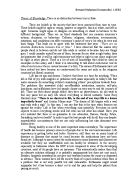Furthermore, we don’t walk into a room and take in all that is going on. Following the Gestalt theorem, when we walk into that room, we take in what we are seeing as a whole rather than identifying individual characteristics. It is not until we use our knowledge of that situation to process what we are really seeing.
To explain this further let me take an example. When we drive to work or school, we generally take the same route daily. When taking that route, we use of knowledge of the first, second and however many more drives to allow us to know what we should see and therefore see it as one long object (the object being the route we take) we don’t notice each individual object we pass because we know they are there and process it as a whole. However if one day an anomaly were to occur such as a new building, the object now breaks down into parts and we then process each of them separately. Therefore, it is our brains and predetermined knowledge telling us what to see. Had we not had the knowledge of that route, it is unlikely that we would have noticed the change, but with knowledge, our brains allowed us to train in on the change in scenery and process the new object we were seeing.
We take in things we want to. A lot of the time, if we chose to focus on something we may miss out on various other things occurring at the same moment, as was shown with the selective vision test in which viewers did not see the gorilla when counting the amount of passes the white team made. In this case, how can we base our knowledge on what we see, if we chose to be selective and chose what we want to see. It is selective to the viewer’s limitations and interpretations.
When looking at the process of sense perception, one could believe that what we see is really what it is. This is called common sense realism and is a comparatively straight forward process from which we can understand out surroundings. However, those who believe this no not allow observation to affect what they are seeing; meaning that such individuals will solidly believe an idea of fact, even of all surroundings point away from it, leading to incorrect assumptions and potentially huge gaps in their knowledge. These people will most likely believe that they eyes are simply the origin of sight and not the knowledge.
There is the Scientific realism way of seeing that is slightly closer to the idea that knowledge is the true origin of sight because they believe that the world is very different to the way we see it and is almost and self-determining reality. This means that when seeing something they use knowledge from science to process what it really is. And is why that we now understand that objects are composed of atoms and molecules and what we see is just the bumping of charged particles together in a certain shape to form objects such as desks, chairs etc.
However, Phenomenalism is really what is in support of the theory of knowledge being the true organ of sight. This perception adheres to the idea that all knowledge must have some base to it from previous experience, which is a very empiricist approach. It means that without previous knowledge of a situation we cannot possible determine what is really going on or take in our surroundings to a sufficient degree. Had you not been told that that object over was a football before and at some point played with it by kicking it across a field, you would have no real understanding of what you were looking at. Even if you had not seen the football before, you may be able to work out the basic idea of what it is by using your knowledge. You know that balls are generally sports items, and you know that it is in a field, which is an area that you use to play in. It is our knowledge that leads us to recognise what we are seeing.
The process of seeing occurs by viewing and external stimulus, having light reflected into your eye depending on the amount available and then having the optic nerve send signals to the brain to process it and interpret it as sense data. Now if the eyes were the true organ of sight, then we would not need the signals sent to our brains to process the information, we would be able to use solely our eyes. However, with the knowledge we hold in our brains, we can successfully identify the stimulus and that is why I support the quote.
In conclusion, if what is written above is correct, our sight really is heavily limited by our knowledge. This could be why certain colonies like Eskimos have many, many different words for snow, because they have knowledge of their surroundings and therefore can interpret many different types, and why certain civilisations such as the Himba of northern Namibia, have words and therefore interpret colours in five categories rather than essential eleven categories we have. For them, water is seen as white and the sky as black and therefore blue and green fall into the same word. This shows us that our knowledge really does have an effect on the way we see things and it is not just the reflected light that we process. This means that the more we learn as human beings, the more we can see and understand of the world surrounding us.
TOK | PageLauren Alden 12B








